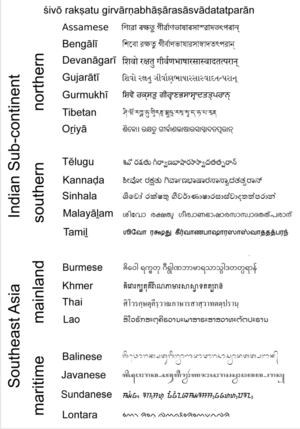Sanskrit is an oral language and has no written script of it's own.
What? Then how is it written? Well, with any style of script really. Some examples are shown below.
 |
| Sanskrit can be written in a variety of scripts |
 First of all, I played a game (feel free to try it out!) in an attempt to decipher an ancient Indian script called the Indus Valley script which was developed around 2600BC. I was in for quite a surprise. I was asked to take various symbols found on ancient tablets and decide if they represented the same letter or not. At the end of the game, I was not told the "correct" answer like I expected! Instead, I was shown responses from 3 different experts who each commented with their opinion on whether they were different letters or not! Each expert had his own reasoning and proofs, but none of them could say for sure. That particular script has yet to be translated! But is cited as the earliest script in India.
First of all, I played a game (feel free to try it out!) in an attempt to decipher an ancient Indian script called the Indus Valley script which was developed around 2600BC. I was in for quite a surprise. I was asked to take various symbols found on ancient tablets and decide if they represented the same letter or not. At the end of the game, I was not told the "correct" answer like I expected! Instead, I was shown responses from 3 different experts who each commented with their opinion on whether they were different letters or not! Each expert had his own reasoning and proofs, but none of them could say for sure. That particular script has yet to be translated! But is cited as the earliest script in India.Devanagari has become the most widely accepted script used for writing in Sanskrit. I've posted a video that demonstrates how the vowels are hand-drawn.
 Devanagari is descended from one of the world's most important (judged by antiquity and influence) writing systems: Brahmi. Brahmi is a syllabic alphabet, which means that each letter represents a single syllable coupled with the inherent vowel /a/ (or just the consonant). Brahmi is ancestor to hundreds of scripts found throughout Asia. The earliest example found dates back to 5th century BC! Interestingly enough, the earliest examples of Brahmi were used to write in Prakrit. Now Prakrit is a linguistic decendant of Sanskrit, yet the first example of written Sanskrit dates back to 1st century BCE, long after Prakrit languages were first written down! What a paradox! This just does to show that Sanskrit was meant to be oral.
Devanagari is descended from one of the world's most important (judged by antiquity and influence) writing systems: Brahmi. Brahmi is a syllabic alphabet, which means that each letter represents a single syllable coupled with the inherent vowel /a/ (or just the consonant). Brahmi is ancestor to hundreds of scripts found throughout Asia. The earliest example found dates back to 5th century BC! Interestingly enough, the earliest examples of Brahmi were used to write in Prakrit. Now Prakrit is a linguistic decendant of Sanskrit, yet the first example of written Sanskrit dates back to 1st century BCE, long after Prakrit languages were first written down! What a paradox! This just does to show that Sanskrit was meant to be oral.
Sanskrit is still chanted in rituals and ceremonies because it is believed that the language brings power to the words. Here I have included the video of someone reading from the Bhagavad-Gita, a sacred Hindu text that I've been studying. I hope you will take a few minutes to listen since Sanskrit is considered to be an oral tongue only, not to be studied on paper.
Unfortunately, today Sanskrit is considered a "dead" language. Not in the sense that no one knows what is means or how to speak it, but rather in the sense that it is no longer used to develop new ideas. Sanskrit has been reduced to a ceremonial tongue, forced to only regurgitate old thoughts and ideas. So I pose the question, does language have any worth if it can no longer be used to spread new ideas?
To answer your question, Jake I would say yes. Much of what we have been learning in class is how knowledge is passed down and preserved with drastic changes in knowledge media. Even a language that is no longer used to develop new ideas, like Sanskrit or Latin, can be very important to preserving knowledge and traditions like the sacred Hindu beliefs, or the scientific use of Latin.
ReplyDeleteSanskrit is certainly much more complicated than I originally imagined. I just know it's one of the fonts available for my Word. I didn't realize it was an oral language. As I was looking at the sanskrit in the video and how it is written, it reminded me an experience I had. I once had a henna party with my roommates and we actually started copying some Arabic and other sanskrit on our bodies. It was rather difficult but after a couple of times, we were able to copy it close to the original.
ReplyDeleteI had no idea how each character was recognized since to me it just looked like a pretty design.
What an art form it is!